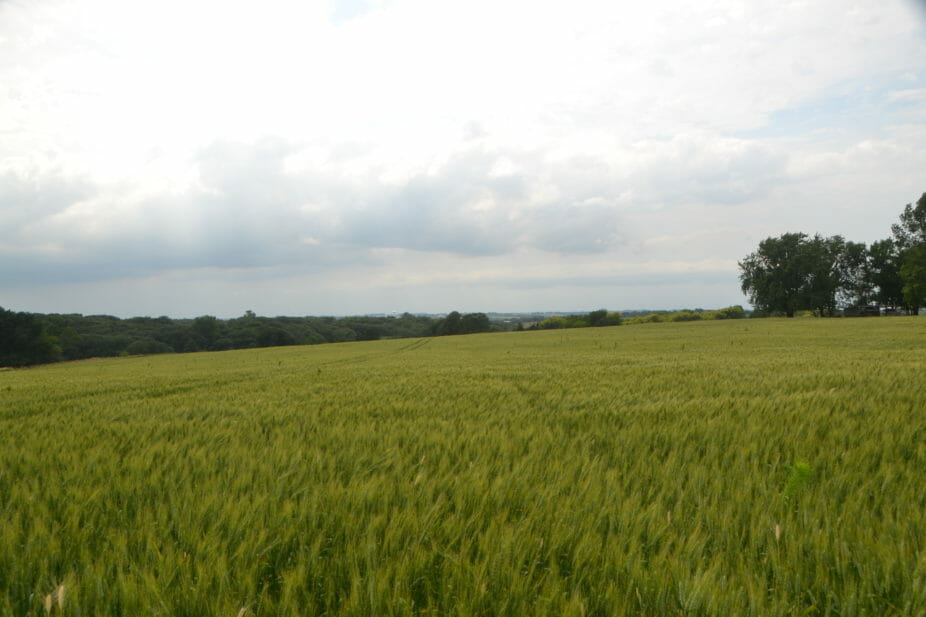Why I Grow Small Grains: Nathan Anderson

Nathan Anderson harvests spring wheat on July 21, 2016. Photo courtesy of Nathan Anderson.
Nathan Anderson of Bobolink Prairie Farms in northwest Iowa recently hosted a field day with his wife Sarah, where he told the crowd some of the reasons that he grows small grains. The Andersons also raise corn, soybeans and grass-fed beef. You can read a recap of that field day at https://www.practicalfarmers.org/blog/2016/06/30/field-day-recap-managed-grazing/. In addition to talking small grains, the field day included discussions of pasture improvement, rotational grazing and grazing multi-species cover crop mixes planted after small grains harvests.
This year, Nathan grew Prevail, a hard red spring wheat developed in South Dakota. He says that because it’s a shorter variety, it will be less prone to lodging in the windy conditions on his farm. The wheat was seeded on April 12 with an air seeder at 120 lbs/ac, and was vertically tilled into soybean stubble. He aims to grind some for feed and sell the rest into a conventional market. You can find more resources on how to profitably grow small grains here.
5 Reasons to Grow Small Grains in Iowa
1. Profitability.
With falling commodity prices, Nathan says that corn and soybeans are becoming merely break-even crops. After reading the research of Matt Liebman at Iowa State University, showing that the financial returns of 3 and 4 year rotations are the same as 2 year rotations, he became intrigued. There are a number of reasons why diverse rotations can be profitable, but they all boil down to a long-standing Practical Farmers of Iowa tradition: reducing input costs in the form of seed, fertilizers, herbicides and pesticides. In addition to those more common input costs, because Nathan uses several species of cover crops on his farm, growing certain small grains and saving the seed allows him to save money on cover crop seeding costs as well.
2. Extend the growing (and grazing) season.
Nathan says that growing small grains allows him to make better use of the early spring and late fall potential for growing crops. While he grows cover crops on corn and soybean ground to expand his grazing acreage without taking land out of row crop production, growing a small grain allows him to expand that even further: planting a diverse cover crop mix in early August after the small grain harvest allows him to turn some of that summer heat into late season forage for his cattle.
3. Improve the soil.
While small grains themselves have a different rooting system than corn and soybeans, the diverse cover crop mix that Nathan will plant after harvesting his wheat will inject roots of different sizes into different depths of the soil, creating pathways for air and water movement, as well as beneficial soil organisms like earthworms.
4. Diversify weed and pest management.
Because small grains germinate and grow at cooler temperatures, they can suppress a different set of weeds than corn and soybeans. Using different methods to control weeds reduces the need for herbicides. Dr. Liebman’s research also shows that diverse crop rotations help control sudden death syndrome (SDS) in soybeans.
5. Strengthen Iowa.
“We have a responsibility to care for our natural resources to safeguard the current and future productivity of agriculture in our state,” Nathan says, “We can do that by diversifying our farms – incorporating small grains, cover crops, and integrating our livestock back into our cropping systems. I think more diversity on farms across the landscape is something that can help us as a state.” He believes that a more diverse farm economy will be more resilient: better to absorb shocks from volatile markets and weather.

Waving field of wheat, Nathan Anderson’s small grain of choice in 2016.
